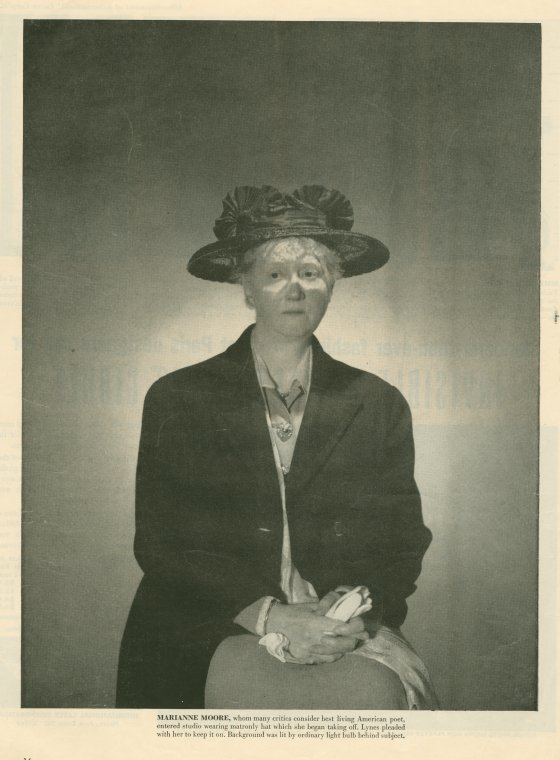
Marianne Moore
A Pulitzer Prize winning poet, Marianne Moore used her poetry and fame to advocate for the preservation of various sites in New York City, especially in Prospect and Central Parks.
Marianne Moore was born in 1887, received a BA in biology and histology from Bryn Mawr College and moved to New York City with her mother in 1918.[1] In 1921, she began working at the New York Public Library.[2] Moore was the editor of The Dial, an influential literary magazine in Greenwich Village, from 1925-1929.[3] She later moved to Brooklyn and lived there for decades before returning to Manhattan.[4] Moore was an especially gifted writer and won the Pulitzer Prize in poetry as well as the National Book Award in 1951.[5] Moore passed away in 1972.[6]
President: Greensward Foundation
Founder: Friends of Prospect Park
Moore’s preservation activism blossomed in the later chapters of her life. In 1961, Moore and other prominent poets called for the preservation of the Walt Whitman building, the former Rome Brothers print shop where Whitman had first printed Leaves of Grass in 1855, which was scheduled for demolition.7 She also wrote a poem on the preservation of Carnegie Hall entitled "Carnegie Hall: Rescued.”8 In 1964, the 1904 Boat House in Prospect Park designed by Helmle & Huberty was within 48 hours of total demolition.9 Moore wrote an appeal to save the building and attended a City Hall hearing supporting its restoration.10
Moore’s passion for preservation continued with her election to the presidency of the Greensward Foundation – an advocacy group with an emphasis on preserving public parks.11 She also helped found a citizen’s group – Friends of Prospect Park, which, too, focused on preservation.12 Moore had a special interest in preserving a Camperdown Elm tree gifted to Prospect Park in 1872.13 She immortalized it in a rallying cry poem, “The Camperdown Elm,” published in 1967 in the New Yorker.14 The tree became known as the most famous tree in Prospect Park, and it is mentioned specifically in the scenic landmark designation for Prospect Park.15 Moore even asked that in lieu of flowers for her funeral that donations be made to save the tree.16 Her efforts were successful and she was asked to take part in other campaigns, like the preservation of a magnolia tree located in Bedford-Stuyvesant and to advocate against the development of several acres of Central Park for the building of the NYPD’s horse stables.17 In 1972, 100 years after the Camperdown Elm was planted, Moore passed away, establishing in her will the Marianne Moore Remembrance Fund which provided support for the elm and other trees in both Prospect Park and Central Park.18 In 1975, Prospect Park was designated a scenic landmark in New York City.19 The report mentions Moore and her tree by name, emphasizing the impact of her preservation activism.
- Rosenbach Museum
- Marianne Moore Collection
- 2008-2010 Delancey Place
- Philadelphia, PA 19103
- https://rosenbach.org/collection/marianne-moore-collection/
- Duke University Library
- Barbaralee Diamonstein-Spielvogel Collection
- Marianne Moore
- https://archives.lib.duke.edu/catalog/bdiamon_aspace_a7d4673de9618ce905db847053a2d131
[1] “Marianne Moore,” Poetry Foundation, accessed 6 September 2021, https://www.poetryfoundation.org/poets/marianne-moore; and Andrew Berman, “20 transformative women of Greenwich Village,” 6sqft, 7 March 2019, https://www.6sqft.com/20-transformative-women-of-greenwich-village/.
[2] John Flood, “Marianne Moore and the Shore Commute,” NYPL, 1 April 2009, https://www.nypl.org/blog/2009/04/01/marianne-moore-and-short-commute.
[3] Andrew Berman, “20 transformative women of Greenwich Village,” 6sqft, 7 March 2019, https://www.6sqft.com/20-transformative-women-of-greenwich-village/.
[4] Andrew Berman, “20 transformative women of Greenwich Village,” 6sqft, 7 March 2019, https://www.6sqft.com/20-transformative-women-of-greenwich-village/.
[5] “Marianne Moore,” Poetry Foundation, accessed 6 September 2021, https://www.poetryfoundation.org/poets/marianne-moore.
[6] “Marianne Moore Dies,” New York Times, 6 February 1972. https://www.nytimes.com/1972/02/06/archives/marianne-moore-dies-marianne-moore-poet-who-was-pulitzer-laureate.html
[7] “Poets Call on City and State to Save Whitman Building.” New York Times, 30 October 1961. http://ezproxy.cul.columbia.edu/login?url=https://www-proquest-com.ezproxy.cul.columbia.edu/historical-newspapers/poets-call-on-city-state-save-whitman-building/docview/115275339/se-2?accountid=10226.
[8] Marianne Moore, Complete Poems of Marianne Moore, (New York: Macmillan, 1981).
[9] “Prospect Park Boat House,” New York City Landmarks Preservation Commission, accessed 1 October 2021, http://s-media.nyc.gov/agencies/lpc/lp/0004.pdf; and Martin Tolchin, “A Gaslight Relic Awaits Verdict: Prospect Park Boathouse May Face Demolition,” New York Times, 14 September 1964.
[10] M.M. Graff, “Remembering Marianne Moore” Clay Lancaster’s Prospect Park Handbook, accessed 13 September 2021, https://www.echonyc.com/~parks/books/handbook.html#remembering.
[11] Maria Popova, “Marianne Moore and the Crowning Curio: How a Poem Saved One of the World’s Rarest and Most Majestic Trees,” brainpickings, accessed 6 September 2021, https://www.brainpickings.org/2015/08/13/marianne-moore-camperdown-elm/.
[12] Maria Popova, “Marianne Moore and the Crowning Curio: How a Poem Saved One of the World’s Rarest and Most Majestic Trees,” brainpickings, accessed 6 September 2021, https://www.brainpickings.org/2015/08/13/marianne-moore-camperdown-elm/.
[13] “Camperdown Elm near Prospect Park Boathouse,” NYC Parks, accessed 10 September 2021, https://www.nycgovparks.org/facilities/great-trees?id=8.
[14] Marianne Moore, “The Camperdown Elm,” New Yorker, 15 September 1967, https://www.newyorker.com/magazine/1967/09/23/the-camperdown-elm; and Marianne C. Moore, “Topics: Crossing Brooklyn Bridge a at Twilight.” New York Times, 5 August 1967. http://ezproxy.cul.columbia.edu/login?url=https://www-proquest-com.ezproxy.cul.columbia.edu/historical-newspapers/topics-crossing-brooklyn-bridge-at-twilight/docview/117808918/se-2?accountid=10226.
[15] “Prospect Park,” New York City Landmarks Preservation Commission, accessed 10 September 2021. http://s-media.nyc.gov/agencies/lpc/lp/0903.pdf.
[16] Kirby Olson, “Marianne Moore’s “The Camperdown Elm” and The Revival of Brooklyn’s Prospect Park,” Journal of Ecocriticism 3, no. 2 (2011): 17, https://core.ac.uk/download/pdf/229585083.pdf.
[17] Kirby Olson, “Marianne Moore’s “The Camperdown Elm” and The Revival of Brooklyn’s Prospect Park,” Journal of Ecocriticism 3, no. 2 (2011): 19, https://core.ac.uk/download/pdf/229585083.pdf; and Constance Feeley, “Preserving the Greensward,” New Yorker, 28 February 1969, https://www.newyorker.com/magazine/1969/03/08/preserving-the-greensward.
[18] M.M. Graff, “Remembering Marianne Moore” Clay Lancaster’s Prospect Park Handbook, accessed 13 September 2021, https://www.echonyc.com/~parks/books/handbook.html#remembering; and “Marianne Moore Dies,” New York Times, 6 February 1972. https://www.nytimes.com/1972/02/06/archives/marianne-moore-dies-marianne-moore-poet-who-was-pulitzer-laureate.html.
[19] “Prospect Park,” New York City Landmarks Preservation Commission, accessed 10 September 2021. http://s-media.nyc.gov/agencies/lpc/lp/0903.pdf.